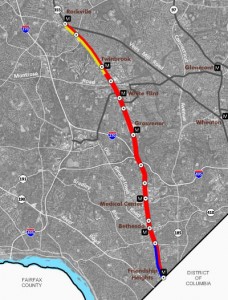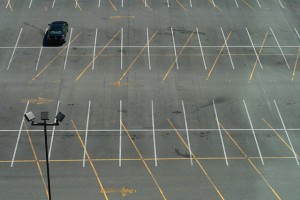FOR IMMEDIATE RELEASE
Friday, August 2, 2013
Contact:
Kelly Blynn, Coalition for Smarter Growth, 202-675-0016 x 127
Ben Ross, Action Committee for Transit, 301-706-6826
Advocates urge Gov. O’Malley to target funds to transportation projects supporting smart growth
Gov. O’Malley to announce transportation spending on Monday in Bethesda
In advance of Governor O’Malley’s visit to Bethesda on Monday, several advocacy groups working in Prince George’s and Montgomery Counties released a letter Friday applauding funding pledged so far for transit, bicycling, and pedestrian infrastructure, while expressing concern over costly new highway capacity projects.
“All of our groups worked hard to build grassroots support for the transportation funding bill so we could have the ability to help realize Maryland’s smart growth and climate protection goals,” said Cheryl Cort, Policy Director at Coalition for Smarter Growth. “Now we’re concerned about how much of the money will go to projects that undermine those efforts.”
The concerns stem from the long list of costly highway capacity projects identified by each County as high priorities, and a state selection process that is done behind closed doors. A few weeks ago, those fears were confirmed when O’Malley announced his list of projects for Prince George’s that included two major new road capacity projects for $250 million
“$150 million for an interchange at MD 4 and the Suitland Parkway is a massive public investment to support sprawling development,” said Karren Pope-Onwukwe, co-chair of Prince George’s Advocates for Community-based Transit. “This new interchange project will draw activity away from Metro stations and inside the Beltway communities, where we should be focusing development.”
In Montgomery, concerns center around four new road widening and interchange projects within the Route 28/198 corridor. These would cost half a billion dollars to duplicate the ICC, drawing away commuters and toll revenue.
“We have already wasted more than $2 billion on the ICC, which continues to be underutilized,” said Ethan Goffman of the Montgomery County Sierra Club. “Our investments should be in reducing carbon emissions and sprawl, not simply adding more and more capacity for cars.”
In addition, previous announcements indicate that Maryland may use a public-private partnership, effectively borrowing against future revenues, to help pay for Montgomery and Prince George’s top priority transportation project, the Purple Line.
“While we’re thrilled with the Purple Line’s continued progress, we’re concerned about the state’s desire to provide the local share of construction funding via a public-private partnership,” said Ben Ross, vice president of the Action Committee for Transit which has worked for the Purple Line for more than 25 years. “We need the full $1.1 billion to open the line by 2020. State funds that may be needed for that purpose should not be committed to lower-priority projects until we are certain that alternative financing is a good deal for taxpayers and riders.”
Advocates listed their top priorities for the suburban Washington region as building the Purple Line, funding the MARC Growth and Investment Plan, and funding Maryland’s share for WMATA’s reinvestment plan, Momentum. They also urged the state to expand investment in local road improvements to create new options for drivers, bicyclists, and pedestrians, such as a multimodal redesign of MD 355 (Rockville Pike) in the White Flint area.
Following on the heels of O’Malley’s announcement of his ambitious goals for addressing climate change last week, including doubling transit ridership, advocates hope his transportation announcements will remain consistent. “We want to see the Governor ensure that all transportation projects funded by the state support the excellent smart growth and climate goals his administration has set,” said Kelly Blynn, Coalition for Smarter Growth.
The transportation advocates’ letter can be found here and is signed by the Action Committee for Transit, Bike Maryland, Clean Water Action, Coalition for Smarter Growth, Prince George’s Advocates for Community-based Transit, Montgomery County Sierra Club, Montgomery County Young Democrats, Montgomery Countryside Alliance, Prince George’s County Young Democrats, and the Washington Area Bicyclists Association (WABA).
About the Coalition for Smarter Growth
The Coalition for Smarter Growth is the leading organization in the Washington D.C. region dedicated to making the case for smart growth. Our mission is to promote walkable, inclusive, and transit-oriented communities, and the land use and transportation policies needed to make those communities flourish. To learn more, visit the Coalition’s website at www.smartergrowth.net.
###







